The Heavy Legacies of Our Past
Previous
Next
Up
Home
This article explores the legacies of past empires and how they shape the world today. The Roman, Islamic, Spanish, Central American, French and British empires all left a deep and identifiable footprint on modern society and politics. The social institutions that built these empires shape the way we interact with our fellow man. It is my hope that a sound historical perspective will inform the causes of our great failures and successes and encourage us to face up to the challenges and threats that continue to stalk modern civilisation.
Below, I present a brief groundwork of ancient history, a recently developed tool for measuring civilisation, a discussion of the ultimate causes of the rise and fall of the Roman and Islamic empires, Islam’s legacy, context to the European Dark Ages, the decline of slavery, the role of freedom, democracy, population and technology in wealth creation, Rome’s political legacy, and how the more recent European and Native American empires have shaped the modern world.
To start with, I will present a brief history of the “centres of western civilisation” that preceded the Roman Republic.
Significant agriculture began about 12 500 years ago, in modern day Iraq (and soon after in China, India and the Americas). The Iraqi societies are the origin of western civilisation. That is, western civilisation spread from there in a variety of ways rather than arising (completely) independently. The first urban civilisations began around 5500 to 4000 BC as the centre of civilisation moved slightly east, towards and into modern day Iran. The first major innovation was the development of irrigation agriculture, and it spawned the first ‘cities’.
From there, the centre of western civilisation moved west to Egypt. Upper and Lower Egypt were unified in approximately 3100 BC by the first pharaoh. Egypt was less arid at the time, but a gradual drying forced large populations to rely more on the Nile flood plains and irrigation. What followed were three successive, relatively stable kingdoms, separated by periods of relative instability.
From Egypt, the centre of western civilisation moved to Rome, as its empire expanded and eventually swallowed Egypt and the cradle of civilisation in Iraq. This was again followed by a significant decline. The Islamic Caliphate was the next large empire and, following its decline, the British.
By now you should be wondering how this social development is measured; the answer is, with a human development index. You may be familiar with these from the work of aid organisations. Historian Ian Morris has developed one for the purpose of analysing historical societies. So here it is, the first ever quantitative measure of our history:
Discuss Ian Morris' historical human development index and his sweeping analysis of human history
Discuss the perspective this adds to the Islamic golden age
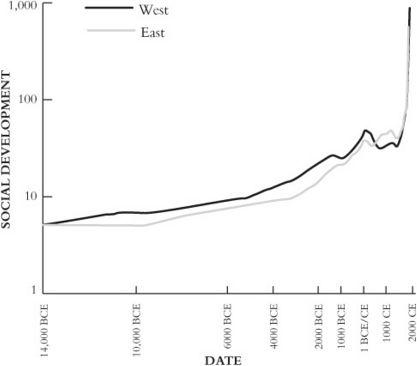
The index is based on four measures of human development - energy capture per capita, organization, information technology, and war-making capacity. These measures tended to be consistent with each other and with other available information. The power of this information is that it allows a sweeping perspective over the entire history of civilisation. History is no longer 'a bunch of stuff that happened,' but has a perspective that reaches all the way back to our ancient past. This has enabled new insights into the consistent trends of our history.
The peak in western civilisation about 2000 years ago captures the rise and fall of Rome. The rise and fall of the Islamic Caliphate – a much larger empire, fell entirely within the trough (valley) following this. The coinciding spike in eastern social development is the Song Dynasty in China, which peaked at roughly the same time as the Islamic 'Golden Age' and achieved much higher living standards. The recent spike is the result of the Industrial Revolution. The Song Dynasty achieved roughly the same level of development as the Roman Empire and came a bit closer to triggering their own industrial revolution. It was not until the Industrial Revolution kicked off in western Europe that living standards finally exceeded those of the Roman Empire – which is why some people familiar with the history are so fond of invoking the ‘glory’ of Rome.
The key lesson from this this analysis is that the development of civilisation is not smooth. It was driven by a surprisingly small number of 'great leaps' forward, where significant development happened over a short period of time. As society grew more complex, these were always followed by leaps backward. All was never lost in these collapses, and if you zoom out far enough the trend continued inexorably higher. What may be more surprising, or even concerning, is the persistence of each collapse – typically about 1000 years. The bigger they are, the harder (and longer) they fall. Maybe all those Mad Max movies are not so fanciful after all.
Historians are also starting to ponder a curious fact made plain by Morris’ index; that both the Roman Empire and the Song Dynasty peaked at roughly the same level of development. One theory is that this was caused by a natural barrier in the form of energy sources. Higher living standards could not be achieved until a more powerful energy source became available in the form of fossil fuels.
Another interesting trend that has long been prone to misinterpretation is the recent shift in the world’s wealth from the tropics and sub-tropics to temperate regions. The Roman Republic pushed the cold northern boundaries, but they soon pushed back. The Industrial Revolution arose from its footprint and turned the world on its head.
It may not necessarily be the case (as is often argued) that colder temperatures have caused this by making people more industrious and forcing them to plan ahead. Rather, this is part of a broader pattern of history, and I argue here that the poor environmental conditions eventually made these societies richer and more powerful by first making them more liberal and inclusive.
The centres of western civilisation have moved several times in our history. Each time, the new centre arose in a backwater of the old and rode on the back of some kind of revolution to sweep the old aside. Europe was an uncivilised backwater, in every sense of the word, until relatively recently. In every case of complex society arising independently, it was in a warm climate where natural advantages made life a bit easier in some way. In contrast, Europe’s cold climate kept it a backwater until civilisation imposed itself. Further, the climate made slave-like arrangements less successful. There are several documented cases of such societies failing due to natural hardships, then flourishing when an alternative, more free way of life came to replace it. The shift in wealth and power from warmer to cooler climates followed (rather than caused) this trend – complex society expanding into colder climates in the form of more free and democratic (politically and economic inclusive) societies.
The existence of complex society with centralised government that is not aggressively (and from our vantage point, destructively) oppressive is a relatively recent phenomenon. The wealth and power quickly followed, and helped these societies conquer the world. This is not a ‘natural’ arrangement, but probably became inevitable as civilisation expanded into places where the destructive influence of oppressive government combined with environmental disadvantage gave the ‘new alternative’ a little breathing room. It only needed to happen once, but if you delve into the detail of history you can see that where conditions were right, the key developments took place along several parallel paths.
As suggested above, I place the start of this transition with the rise of the Roman Republic. The following maps show the expansion of the Roman Republic and Empire and its subsequent contraction and collapse, and the rapid expansion of the Islamic empire (i.e., the first ‘Caliphate’) in its wake. These were the 'interesting times' of history, when the old was swept away by the new.
The Roman Republic was a slow starter. It took over 3 centuries (500 BC to 200 BC) to capture the Italian Peninsula:
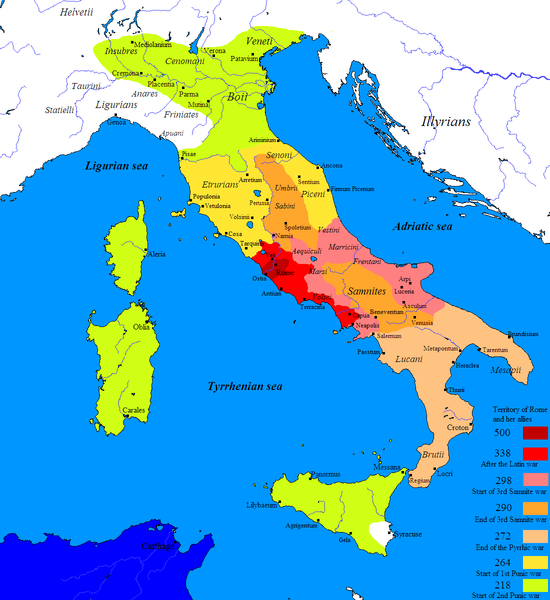
The Republic and Empire expanded over the next 3 centuries to incorporate those old centres of western civilisation - Egypt and, in the far right bottom corner, those Iraqi societies that were the seed of western civilisation. In 27 BC, the Republic ended and the Roman Empire began, when the Roman Senate officially gave Octavian (Augustus) Caesar dictatorial powers. They may have thought it was a good idea at the time, but today dictator has become a bad word.
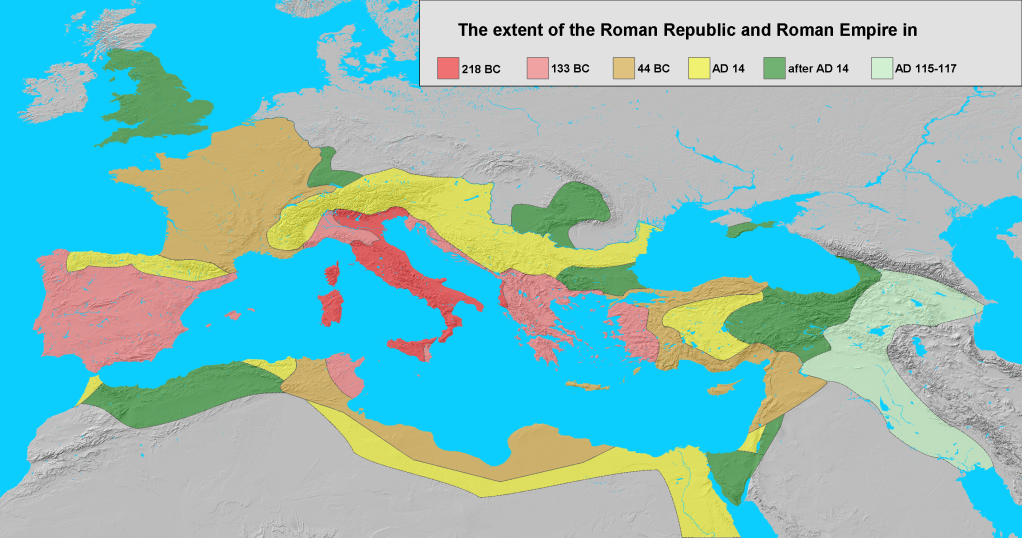
By 400 AD, the Empire has shrunk slightly, then split in two:
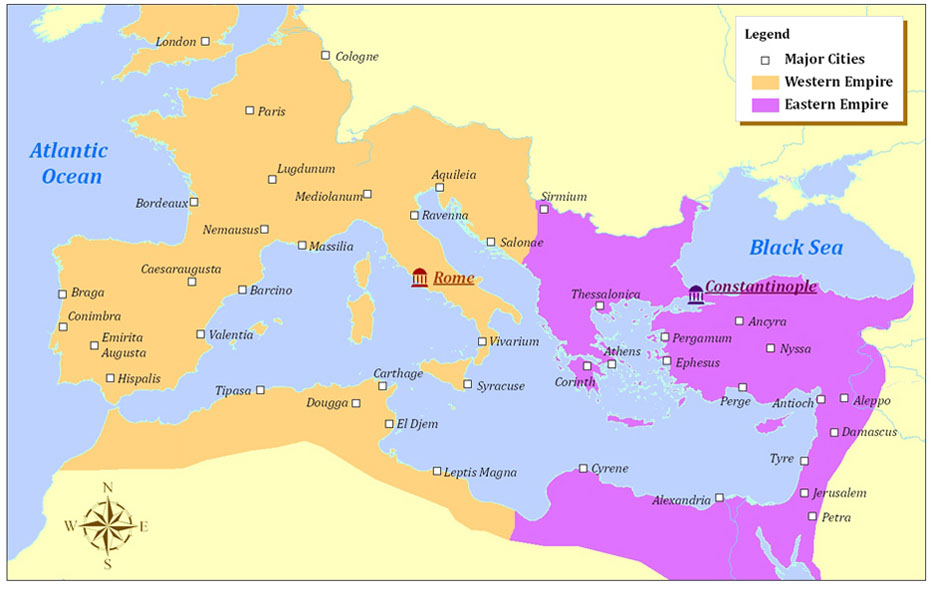
By 526, invading European tribes from the ‘uncivilised backwater’ had dismantled the western half and created European states on a similar scale to modern ones:
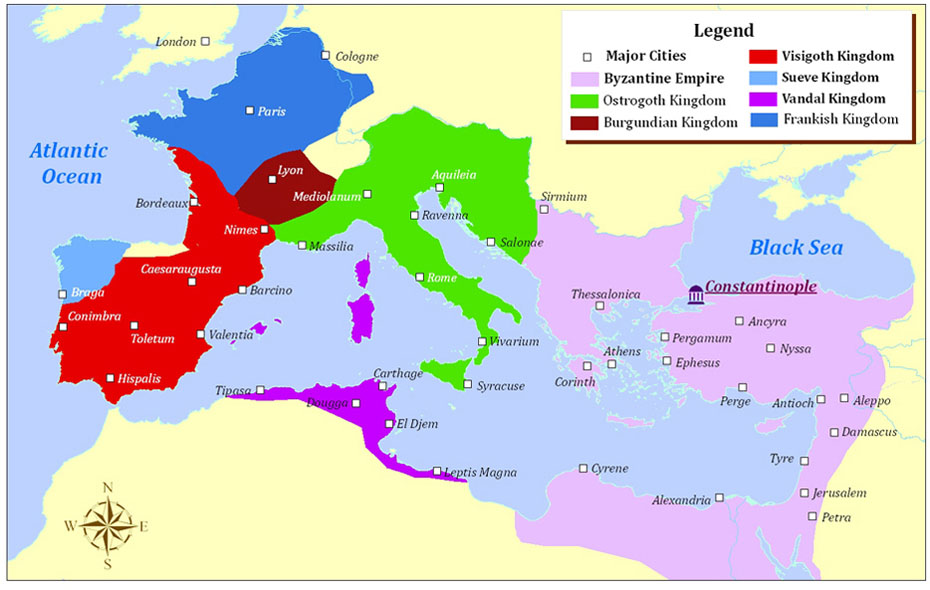
It is easy to conclude that the European tribes caused the end of the Roman Empire, however Morris’s index of historical development demonstrates that they were a symptom of Rome’s decline, not a cause. Rome had been declining for five centuries before they finally swept it aside. Likewise, the internal split was a late symptom, rather than a cause of the weakness.
So what drove the rise and fall of Rome?
The broad outline of civilisation’s history shows a gradual transition from civilisation defined by agricultural revolution to civilisation defined by ‘political’ (I use the term very broadly) revolution. The God-like status adopted by Egyptian pharaohs no doubt helped them maintain control over their kingdoms.
The rise of the Roman Republic was ultimately driven by an almost unique political concept – that people should have a say in how they are ruled. The Greeks had done impressive things with direct democracy, but this has obvious limitations as the number of people involved grows. Much like Greece, Rome limited voting rights to free adult male citizens. There were additional arrangements that effectively limited the voting power of the poor. They did not have a legislative assembly. New laws were enacted through a form of direct democracy. The Senate had an administrative role and did not propose or pass laws. Two consuls were elected by citizens for an annual term, and had powers similar to previous kings. Beyond this, the Roman constitution gets very complicated. This was in part a deliberate measure designed to achieve a balance of power. The constitution also evolved over time, partly in response to strikes from the poorer citizens demanding greater political rights. The Roman model was significantly inspired by the Greeks, but both Greek and Roman models fell far short of today's standard. The system was not developed with democracy as an end goal, or even out of ideological support or respect for democracy. The only shared goal was that Romans would never again live under the yoke of monarchy. They knew where they were coming from, but not where they were going to. Despite this, Rome's system of government contained sufficient democratic mechanisms to set it apart from competing societies and drive its continual rise over half a millennia.
These principles were eventually discarded and Rome came to be a dictatorship – no different from nearly every previous empire, except for the enormous geographical expanse it ruled. This started in 27 BC with Augustus Caesar, or perhaps earlier with the appointment of Julius Caesar to the position of perpetual dictator in 44 BC (he was assassinated the same year). It is no coincidence that Rome peaked on Morris' index of human development at this time. Inevitable decline eventually followed, driven visibly by violent internal competition, and invisibly (to us) by gradual political and economic exclusion and disengagement that weakened the social fabric needed to hold such a behemoth together. If we step back even further, Rome's decline can be traced to its astonishing success. The model of government created so carefully to maintain a balance of power was simply abandoned to accommodate individuals who had achieved great power on the battlefield. Their battlefield success was in turn ultimately driven by Rome's economic success and the (political) willingness of the people to support it. Even more broadly, Rome was undone by the basic strategy of using constitutional complexity rather than popular values to maintain a balance of power. The model was abandoned so easily because people did not value it. It is hard to blame them. There was nothing pure in it. It was an ad-hoc hybrid of democracy, exclusion and aristocratic privilege held together by complex rule and bureaucracy. And the glory of Rome.
The first Islamic state, known as a Caliphate, arose in a desert backwater that was curiously close to the very first western societies. It swept away the dysfunctional remnants of Rome in just over a century, to become the largest empire the world had seen.
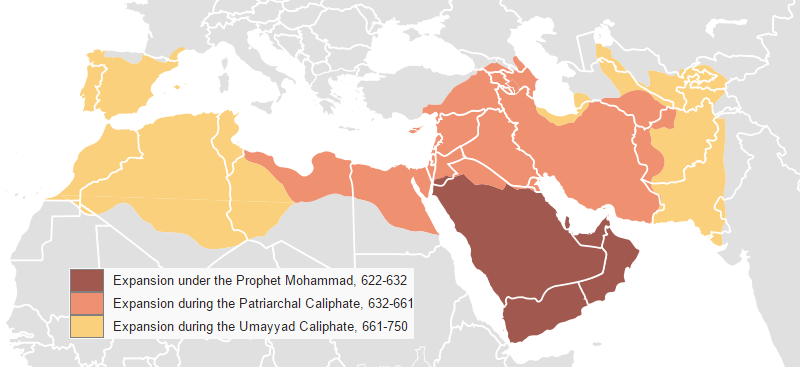
Rome was powered by political inclusiveness (the term used by historian Daron Acemoglu to refer to democracy when the practice does not live up to our modern standards). The Caliphate was, obviously, driven by the ideology of Islam, which has strong and overarching political components. It represented a return to the Egyptian style of governance. Making people religiously devoted to the empire is obviously a good way to solidify support, if only you can make them believe it. The ideology of Islam incorporates many mechanisms to get people to adopt Islam and then prevent them abandoning it.
Islam as a 'faith ratchet'
Thus it is no surprise that places with the longest history of political Islam today have the most religiously devoted followers and the most conservative political and social institutions supporting Islam.
I identified above eight separate ‘centres’ of western civilisation – the first farming societies in southern Iraq, the first irrigation societies nearby, three successive Egyptian Kingdoms, the Roman Republic and Empire, the Caliphate, and the British Empire. All of these civilisations rose from the ashes of previous ones in the same place or from ‘backwaters’ of nearby civilisations, reached a peak, and then declined. All except one of these civilisations brought with it significant advances in human society – bigger, stronger, richer, more complicated, with more impressive technology and more diverse than the previous. That exception is the Caliphate. It was bigger in terms of area, but that is about the extent of its novelty. There were plenty of other smaller empires that also failed to bring about great change. I include the Caliphate here because of its sheer dominance of western civilisation in terms of geography and time, because of its deep footprint on the modern world, and because of persistent efforts to overstate its positive contributions.
When confronted with the stark and consistent differences in living standards between Muslim countries and the developed world, Muslims typically respond in one of two ways – to blame the current situation on western (i.e. American, or historical British) interference, or to invoke the Islamic 'Golden Age.' The key message invoked by the Golden Age is never stated explicitly, but I will do so here: the backwardness of Muslim countries is not caused by Islam and is merely a reflection of the current geopolitical situation, and this point is demonstrated by a very different history in which Muslim countries were actually more advanced than others, especially Europe. Muslims reinforce this argument by invoking the European Dark Ages alongside their Golden Age.
It is my goal here to dismantle this argument, by revealing the reality of the Islamic Golden Age and placing it in proper historical context. I will do the same for the Dark Ages following. I intend to demonstrate that Islam has always had a significant negative impact on any society it dominates. The apparent reversal of fortune invoked by the Golden Age/Dark Age comparison is actually a reflection of the persistent stagnation of Muslim countries coupled with the rest of the world continuing with 'history, as usual' around and despite them. Muslims often cite science as a defining feature of the golden age, and I will also show that the contributions of Muslims to science during the period (and ever since) is meagre and largely overstated.
The main counter-arguments presented here are:
-
The Caliphate (Islamic state or empire) was the largest the world had ever seen;
-
The Caliphate covered an area including almost all of the centres of western civilisation until then;
-
Despite this, living standards and social development were far lower than they were previously in the west;
-
Living standards were lower than those in eastern civilisations at the same time; and
-
The Caliphate came close to destroying the social precursors to liberty, democracy and the Industrial Revolution in Europe.
While Islam proved an impressive mechanism to grow the empire at an astonishing rate, and to a size never seen before, it prevented those mechanisms that were the driver of the great leap forward seen in the Roman Republic. Islamic politics is extremely rigid, with political debate only tolerated regarding how to implement Sharia law correctly. The stagnation of western civilisation under the yoke of Islam is unsurprising, and reflects the same forces undermining Muslim societies today. Like the Roman Republic, the Caliphate was eventually torn apart by internal divisions. Unlike Rome, it rose on the back of political oppression rather than a great political leap forward. Also unlike Rome, the disintegration of the Caliphate was not preceded by a measurable decline from within. The western social development index remained remarkably stable during the rise and fall of the Caliphate, up until Europeon society rose to dominance again on the back of the Industrial Revolution.
The argument I now move on to is not about the cause of the rise and fall of the Caliphate. Rather, my argument is about the impact that Islam had on the people in the Caliphate, and the societies left behind after its collapse. Islam had a wholly detrimental effect on human development during the rise of the Caliphate, the collapse of the Caliphate, and in those societies left behind that were dominated by Islam. It continues to have a detrimental effect today. The longer the history of political Islam, the worse the effect.
Morris’ human development index shows a fairly steady level during the Caliphate. In interpreting this, consider what should have happened as a result of the new empire. While Islam lacked the efforts at political inclusiveness that helped give Rome its edge over rivals, the trading opportunities alone should have produced massive benefits. An empire is a large free trade zone, and the Caliphate was the biggest the world had ever seen. (This is why empires feature so prominently in the history of human development.) On top of that, it straddled the east-west trade route that was growing in significance as links between the eastern, western and to a lesser extent Indian centres of civilisation grew. Muhammed himself started life as a trader. Although he funded his early political career by robbing caravans, he later decided this was actually a bad thing and incorporated barbaric punishments for highway robbery into Islam.
The benefit of all this trade is not seen in the index. It was no doubt there, having an influence. It’s just that the other deleterious effects of Islam largely cancelled it out. The empire was a lost opportunity for the next ‘great leap forward.’
Not only was the Caliphate the biggest empire ever seen and straddling an important trade route, it also managed to incorporate every centre of western civilisation since civilisation itself began, except Rome. It did however capture most of the Roman Empire, including north Africa and Spain. Muslims often attempt to insist that the absence of the rest of the Roman Empire in Europe was a significant cause of this. However, Europe only had a very short history of civilisation at this time, or none at all. East of the Rhine, Germany was still a tribal backwater lost to history. The social institutions built by the Romans were still intact to varying degrees in France, Spain and Italy, but were held by the eastern European tribes that had destroyed the remnants of the empire. The wealth of the Roman Empire was not derived from Italian geography, but from portable political ideas and the massive ‘breadbasket’ territories in North Africa that were now part of the Caliphate. Although the modern world has much wealth accumulated in cold places, this is a recent reversal of the trend for almost all of human history. The Caliphate had the greatest opportunity, but realised only the smallest result.
Islam effectively removed the bulk of western civilisation from the history of human development. It prevented the great leap forward, or at the very least the economic boom times that should have come out of the land empire. Except for Spain, the territories it occupied have been a backwater ever since. All significant human development that has occurred since then has happened outside of this bloc. It is as if a nuclear holocaust wiped out western civilisation, making its geography eternally uninhabitable, forcing social development to continue from its fringes.
Not only did Islam neuter the bulk of western civilisation, it continued to have a significant negative impact beyond its fringes. Muslim Barbary slave traders depopulated the Italian coastline until very recently. They raided the rest of the European coast at regular intervals and made incursions into eastern Europe and Russia in search of slaves. It took several wars by America and Europe and most of the 19th century (and even into the 20th century) to put an end to this. Islamic societies also took slaves from central Africa (another potentially revolutionary fringe of western civilisation) for the entire history of Islam, building some of the most oppressive social institutions in the world. In modern times, the effort at ending this slave trade was never completely finalised. With the recent rise of the latest Islamic State, the ugly spectre of state sanctioned sex slavery has once more reared its ugly head. This is not an aberration. For the entire history of Islam, the steady flow of slaves into Muslim countries was dominated by women.
It is curious that the Islamic slave trade had opposite influences in the northern and southern fringes of western civilisation - Europe and Africa. Perhaps this is because of Africa's more advanced state and greater wealth at the time. Once the Caliphate's military expansion was halted, the traditional source of slaves dried up. While Muslims continued to launch military style raids on European populations to feed their slave trade, in Africa this turned into more of a financial arrangement. That is, they bought slaves. This reinforced the oppressive nature of the African regimes involved. The Europeans then had their turn at buying slaves from the same African traders. While many European colonies around the world are liberal democracies, or heading in that direction, the tin pot dictatorships of central Africa demonstrate the resilience of the most oppressive social institutions, and the dire consequences this has on living standards, even in resource rich nations.
So what is the cause of this Islamic degeneracy? I have already highlighted a significant political difference between the Caliphate and the Roman Republic, in the form of Rome’s political inclusiveness. Another is, surprisingly, inbreeding. Compare for example the map above of the Islamic Caliphate with this map of the current prevalence of cousin marriage.
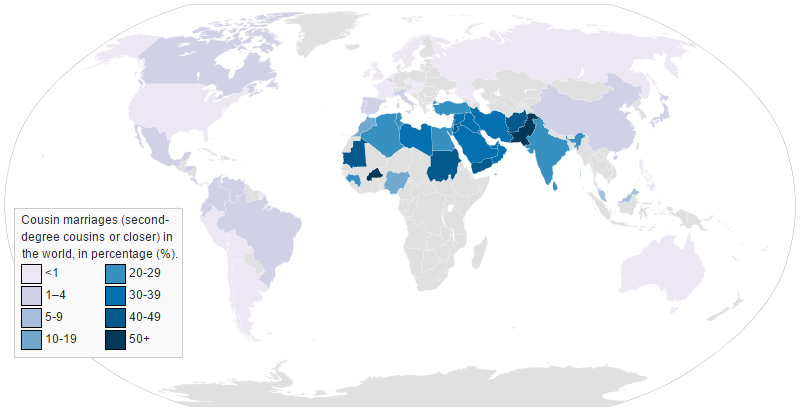
This is no coincidence. Cousin marriage has a strong doctrinal root in Islam, and was practiced by Muhammed and the early 'rightly guided' Caliphs. This inbreeding has a significant influence on the health and intelligence of offspring.
Discuss the significance of Islam's Golden Age
Islamic Incest Ratchet
There are myriad other causes, most of them traceable directly to Islamic doctrine. A cursory look at the current political and social backwardness of these countries will yield plenty of examples, but this will be left to the reader to explore. Wealth is not a cure for these social ills, as the gulf oil states clearly demonstrate. It may appear to help non-Muslim countries, but this gets the causation backwards. The wealth of the modern civilised world is largely a result of socially progressive movements, rather than a cause.
In promoting the Islamic Golden Age, Muslims often invoke science as a defining feature. Two Muslims have won Nobel Prizes in the hard sciences, one of whom belonged to the Ahmadiyya sect which most Muslims don’t recognize as part of their religion. Trinity College in Cambridge has won more. To be fair, the Golden Age happened before Nobel Prizes came about. Talk of the scientific golden age is usually rich with superlatives, but lacks the actual contributions made. So, to cut to the chase, here they are, from Google’s top response for the search term ‘Muslim scientists’.
MUHAMMAD IBN MUSA AL-KHWARIZMI (780 – 850) – contributions to maths
IBN BATTUTA (1304 – 1369) – a traveller who reported his experiences, a bit like Marco Polo
IBN RUSHD (1126 – 1198) – a Spanish Muslim philosopher who argued the inferiority of religious knowledge over scientific knowledge
OMAR KHAYYAM (1048 – 1131) – contributions to maths, poetry and a new calendar
THABIT IBN QURRA (826 – 901) – The concept of static equilibrium. “The medieval astronomical theory of the trepidation of the equinoxes is often attributed to Thabit.”
ABU BAKR AL-RAZI (865 – 925) – apparently a really good physician
JABIR IBN HAIYAN (722 – 804) – alchemy and metallurgy
IBN ISHAQ AL-KINDI (801 – 873) – “Known as the first of the Muslim peripatetic philosophers”
As is typical of such lists, they are remarkably short on actual contributions to science (i.e., our understanding of the natural world) and many of the scientific contributions that are attributed to them are questionable. Instead, they contain a lot of detail about the breadth of their knowledge, how many treatises they wrote or translated and their personal story.
But what of those European Dark Ages?
The Dark Ages' is a reference to the period more commonly known as the Middle Ages. It was often applied to the period spanning the 6th to 14th centuries. More recently this tended to be restricted to the 6th to 10th centuries, while many modern scholars avoid the term altogether because of the misleading imagery it generates.
The social decline following the collapse of the Roman Republic was genuine, and is revealed above in Morris’ historical human development index. It should be kept in mind however that Europe was a backwater of western civilisation up until the Roman Republic, and much of Europe remained a backwater during and after the Roman Empire, and contributed to its final collapse.
As the Romans expanded north into Europe, they encountered a tribal society that had no written history, that used coins, but did not practice much agriculture. Europe was in the early stages of transitioning from a tribal society to one based on stable communities supported by agriculture. Social organisation into geographic states was only beginning in the south as civilisation crept in from the previous western cores. Large migrating tribes would wreak havoc with fixed settlements, consuming and destroying all in their path. The Romans ‘civilised’ the people in modern day Spain, France and much of Britain, but their attempt to expand into modern day Germany ended with a significant military defeat.
Much of the history of both eastern and western civilisations is punctuated by invading tribes from northern Europe, across the central Asian steppes all the way to the frontier of Chinese civilisation. The relatively stable geopolitics we are familiar with today only became possible after these tribes were brought under control by states with relatively stable borders. It was the tribes of eastern Europe that rode in to destroy the remnants of the Roman Empire. Curiously, these tribes set up states with (roughly) identifiable borders, as shown in the maps above. They did not replace the (relatively) more civilised societies left behind by the Romans. Rather, they placed themselves on top of existing political institutions and social structures. This style of government (that is, having some form of government at all and staying put) gradually spread east and became the kingdoms of the middle ages. While it is true that this was a big step down from the society that existed under the Romans in western Europe, it was a big step up for societies to the east. Furthermore, the step backwards for the west was typical of the rise and fall of the defining empires of western civilisation.
Seen in the proper historical context, the Middle Ages were not a step backwards in an otherwise civilised Europe. Rather, the Roman Republic was a massive and unprecedented step forward. This step saw parts of western Europe that had completely lacked stable society leapfrog the rest of western civilisation, forge new ground, and eventually encompass all the historical centres of western civilisation. The decline that followed is commensurate with the collapse of such an empire, and with societies on the fringe of stable civilisation and lacking military protection, thus being invaded by tribes with no history. In this broader context the middle ages then were part of a relatively rapid, though not always steady transition from uncivilised tribal backwater to once again being at the forefront of human development.
This is not intended to reveal something special about Europe. Great revolutions often come from the backwaters of previous civilisations. Furthermore, the head start that western civilisation obtained in the early transition to agriculture was maintained through all of its history, except for the recent period when eastern (Chinese) society achieved a similar feat to the Romans at the same time that the Muslims were crushing humanity in the west. Europe did not invent civilisation, it inherited it from the ever expanding western core.
That the last two great leaps forward in western civilisation (the Roman Republic and the Industrial Revolution) happened in Europe is not so much a reflection of Europe’s special place, but the squandered opportunity of the Islamic Caliphate and the stagnation of the rest of western civilisation under the yoke of Islam ever since. The level of human development seen in the Roman Empire was only matched more than a millennia later in China, and exceeded only after the Industrial Revolution began.
A curious thing happened with the collapse of the Roman Empire. As discussed above, a defining feature of the Republic was its political inclusiveness. This was lost with the transition to dictatorship and the later collapse of the empire. Europe was ruled by dictators calling themselves monarchs. However, in economics there was an equally important and progressive reform – slavery largely came to an end. This was to have far-reaching consequences a millennia later.
In most places the institution of slavery was replaced by serfdom. Serfdom differs fundamentally in that serfs were not considered the property of their ‘master,’ were not subject to involuntary movement (being sold), were allowed to own their own property and accumulate wealth, were not physically punished for not working, were provided with their own plots of land as a form of payment and only worked part time. Serfdom itself ended in roughly the 12th century. Both slavery and serfdom were largely absent from central Europe, perhaps reflecting the historical lack of civilisation.
When Europeans (initially the Spanish) discovered the new world and started participating in the global economy, the absence of slavery in Europe was the exception, not the norm. Europeans participated in the global slave trade, and for a time ramped it up significantly. Yet it was also Europeans who brought an end to slavery. This apparent contradiction is a reflection of two different forces at work. When the Europeans ‘entered’ the global economy, they ramped up all aspects of global trade, including slavery. Slavery occurred on a larger scale because everything the Europeans did was on a larger scale.
European society was itself undergoing a rapid transition initiated by the Roman Republic. The eradication of slavery was part of this transition, and was promoted on ideological and religious grounds. Both Judaism and Christianity have strong sympathies with the plight of slaves through the story of Exodus. The ability of the better-intentioned Europeans to achieve this goal lagged the ability of some Europeans to participate in the slave trade, but does not reflect a lack of will on the part of Europeans and many of their leaders. Even the Spanish crown, perhaps the biggest beneficiary of slavery, made genuine efforts to eradicate it among its own colonies, citing religion as a motivator and justifier. Europeans banned slave owning among themselves long before they managed to prevent Muslim slave traders from raiding Europe’s coast to capture slaves. This too came to an end towards the end of the 19th and start of the 20th century, after roughly a century of wars by European and American powers in pursuit of this goal. This was followed up by a concerted effort to eradicate slavery in the Muslim world itself – an effort that has not entirely come to fruition. Below, I discuss the key feedback mechanism that made this possible - wealth.
It has become popular among socialists and other groups with an axe to grind against capitalism, economic freedom, democracy or even white people in general, to insist that the rise of western Europe and its colonies is a result of slavery. This can be an attractive fallacy, given that the recent rise of European powers coincided with their involvement in the global slave trade. However, it is a correlation, not a causation. I argue here the opposite – that freedom and democracy are the cause of Europe’s rise.
The historian Daron Acemoglu uses the broader terms of political and economic inclusiveness to describe this theory. This is in part to avoid inevitable arguments about what constitutes true freedom, democracy or capitalism. Furthermore, his argument is (rightly) that these are opposite extremes on a spectrum, and more significantly, that this is a naturally polarising spectrum. That is, countries tend to drift towards the nearest end of the spectrum. In his book, Why Nations Fail, he explores the positive feedback loops (i.e., self-reinforcing mechanisms) that make this happen.
To clarify the meaning of these terms, political and economic inclusiveness are the absence of dictatorship and oppression. They are the absence of artificial barriers to becoming wealthy by your own hand, having a say in your governance and becoming a political leader. They are the social institutions (rules, customs, traditions, values, expectations etc) that enable meaningful participation and capture both the number of people with access and the nature of that access. They are a measure of the extent to which a society meets the higher and more absolute standard of liberal, capitalist democracy, and are intended to invoke a spectrum of possibilities between dictatorship and democracy. Where I have used the terms freedom and democracy too broadly above, it reflects the lack of familiar language to communicate these concepts.
The transition from uncivilised freedom, to oppressive civilisation, to liberal civilisation has always been a blind one. Despite our sense of achieving freedom and equality, there is no absolute end to the spectrum. There was nothing fundamental forcing people to live together in greater numbers, though historians have plenty of reasons why it was almost inevitable. There was nothing forcing people to create oppressive regimes in the first large communities, although it happened in parallel plenty of times through history. There was no limit on how oppressive society could become, and our fiction authors have dreamed up all sorts of plausible scenarios. Likewise there is no limit to how far freedom and democracy can spread across the world, or to how much more liberal and politically engaged we could become. The spectrum of inclusiveness may appear to have solid, fixed ends: at one end, slaves building pyramids and on the other, modern society. However this is merely a reflection of our limited experience. In reality we are blindly pushing the boundaries of inclusiveness into unknown territory, like the Romans before us.
Discover how voting by delegable proxy can combine the best aspects of modern representative democracy and Greek-style direct democracy.
To summarise Acemoglu's (expansive) thesis: Political and economic inclusiveness are self-reinforcing, and reinforce each other. They also create wealth. The opposite (oppression and exclusion) are also self-reinforcing. Thus societies tend to drift towards one extreme and the middle ground is unstable. In transitioning to liberal democracy, the theory does not demand one to come first, but predicts that one inevitably follows the other. Likewise, loss of democracy leads inevitably to loss of freedom, and democracy cannot function without freedom of the press, free speech etc. Political and economic inclusiveness refer to institutions that pervade all levels of society and are very resilient. The consequence of this is that liberal democracy and dictatorship are very resilient, as institutions. Dictatorship is far harder to get rid of than merely toppling a dictator. A dictator may fall, but no matter what promises his usurper makes, the existing institutions will almost certainly cause him to become corrupt and dictatorial in order to cling to power. Thus, chopping the head off a corrupt regime and putting democracy there is unlikely to work, because the whole body is corrupt. Likewise, the Nazis may do away with democracy, but if it is institutionalised through society, it will spring back to life if given the chance. Countries between these extremes are at a historical crossroads, but even here intervention is fraught, as the corrupting elements of society are ingrained in the culture. I suspect this is why the US insisted on rooting out the Baathists in Iraq and abandoning much of Iraq's bureaucracy. Likewise, the French were more successful in continental Europe because they were there to stay, intended to turn society on its head, and were not afraid to shed some blood in the process.
Discuss Daron Acemoglu's theory that political and economic inclusiveness are self-reinforcing and the ultimate cause of modern wealth.
In the context of the arguments regarding slavery under recent European imperialism, I would phrase it thus: only a small advantage was needed for European nations to have the upper hand and take over the world. The historical tendency for corrupt nations to reinforce their oppressive social institutions meant that Europe’s competitors were at the opposite end of the spectrum and easy to overtake. This, combined with Islam’s grip on the bulk of western civilisation, meant that European countries did not have far to go to get that upper hand. Although Europe was rapidly transitioning towards liberal democracy, history would not wait for 'perfection', and so a society recently risen from barbarity found itself ruling the world. Thus Europeans ramped up the slave trade, as they ramped up all global trade. But they also brought their liberal morals in whatever form they took at the time, and as the path to liberalism continued they wound down the global slave trade, while continuing to ramp up the free global market.
Discuss the role of slavery in the rise of western Europe
During the Roman Republic, the relative advantage took the form of political inclusiveness – a rough, messy form of democracy that was eventually abandoned, to Rome’s detriment. Later, this advantage took the form of economic inclusiveness. Slavery turned into serfdom, which turned into a free market in human labour every time a plague increased the value of labour and decreased the relative value of capital. Entrepreneurs were more free in western Europe than elsewhere to invest in the Industrial Revolution and take advantage of the mobile workforce (and profit from it). Political inclusiveness came later – a sudden upheaval in mainland Europe, a gradual transition in Britain. This was a long incubation period. The seeds of democracy lay dormant as little more than a memory of Rome, while the absence of slavery was of little value while people were starving in a Malthusian backwater.
In modern China, the communist party is transitioning the country to capitalism. However, the explosive economic growth that is still unfolding owes just as much to the one child policy as it does to economic inclusiveness. The Chinese were literally living and dying a Malthusian hell a generation ago, and those recipes for locust soup are not just a culinary quirk. The one child policy had a similar impact on overall wealth and the value of labour to Europe's great plagues, and the guided transition to capitalism is China's parallel to the Industrial Revolution. Critics of this suggestion often argue that population actually went up in an absolute sense, however it is the relative balance between population, technology and sustainability that affects affluence, and there was no shortage of technology available to China, once they could look past their next meal. If we apply Acemoglu's theory, we expect the rising Chinese middle class to start demanding greater political rights (and hopefully sustainability also) in the near future. Here too there is cause for hope. In a parallel to Europe's 'citizen's assemblies', the Chinese communist party has democratic internal mechanisms. This familiarity with and acceptance of (and hopefully, appreciation for) democracy will no doubt ease the burden of the interesting times that lay ahead.
Discover the link between population, affluence, technology and sustainability.
I now draw your attention back to those parts of western Europe that came under the Roman Republic and Empire. That is, modern day Italy, Spain, France and Britain. Italy ceased to play a defining role in the history of civilisation, at least in part because its coastline was later depopulated by Muslim slave traders. Spain, France and Britain all went on to play a defining role. Ultimately, it was the weakness of the states that permitted the revolutions that define modern society.
At the time that Columbus discovered the Americas, the Spanish, French and British monarchs were getting weaker. They all chose to exchange some political and economic rights with their citizens in exchange for money and political support. All three countries had some kind of citizen’s assembly. No doubt these assemblies were keen promoters of the glory of Rome and the political institutions that fuelled its rise. Although far from democracy, in Britain this assembly was the precursor to the lower house of parliament.
Being the first to discover the Americas, the Spanish got all the good bits. Like the eastern and western civilisations, all the wealth, power and social structure was in the tropical and subtropical parts of America. The technological lead held by western civilisation allowed the Spanish to take the gold and silver and follow this up by placing themselves at the top of every existing social structure in the Americas that had a ‘top’. Although it is tempting to blame the Spanish influence for the corrupt and despotic regimes that plague Latin America today, the reality is that the modern variation in democracy and political inclusiveness reflects the ultimate cause – the social structure of the native American societies, and to take this one step further, the natural wealth these regions held for human civilisation.
Today, the most democratic and free societies in the Americas are the ones that had the most democratic and free (politically and economically inclusive) societies prior to European colonisation. What has been reversed is the distribution of wealth. As with western civilisation, the early American civilisations sprang up in the naturally richer areas, and built extremely oppressive societies. The naturally poorer lands that could not support the same population density had tribal societies that were in their primitive way, more free. Partly because of the natural causes for this, and partly because these social institutions are remarkably persistent, they remain to this day. The wealth has shifted because freedom and democracy are an ultimate cause of wealth in complex societies – ie societies that have transcended the basic natural barriers to supporting high populations. The path to civilisation has taken people from the garden of Eden, where the snake rules, to the cold frontiers, where only freedom can rule.
In fact, the political institutions in the Americas had even more far-reaching consequences. By providing the Spanish crown with gold for centuries, they halted the transition to democracy that was in its infancy. No longer weak and needing to garner support, the Spanish crown simply disbanded its citizen’s assembly.
This left France and Britain as the two remaining countries with a strong Roman influence (i.e. they were part of the Roman Empire). It was these two countries that seeded the explosion of democracy across the world. They took very different paths.
The French had their revolution. They beheaded their own monarchs and marched east, beheading any more they found. However, this was a true revolution in every sense of the world. The kingdoms they invaded (eg in modern day Germany) were even more backward and oppressive than the old French monarchy. The French rebuilt European social and political institutions from the ground up with a genuine devotion to “liberty, equality and fraternity.” The introduction of the Napoleonic Code throughout the continent increased legal equality. The French established jury systems and legalised divorce, abolished seigneurial dues, seigneurial justice and aristocratic privileges in all places with the exception of Poland.
The French revolution and its inheritor, Napoleon, had ready enemies among Europe’s monarchies, who used intermarriage as a tool to maintain the (oppressive) status quo. As a result of Napoleon’s military brilliance and his ability to introduce mass conscription (industrialisation enabled him to arm them, and the revolutionary ideals allowed him to inspire them), France took much of mainland Europe. However, the days of great empires were coming to an end (at least in Europe), and it did not last. This map shows the French sphere of influence in 1812. The empire proper is shown in dark blue, client states in light blue and allies in yellow.
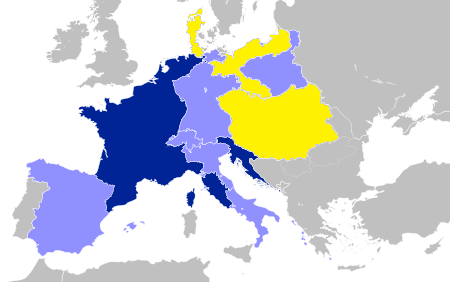
In keeping with the thesis that liberty and democracy are ultimate causes of wealth, the footprint of the French Empire on continental Europe consists of the most liberal and wealthy, and least corrupt democracies. The French Empire may have been short lived, but its legacy lingers like the smell of stale wine and garlic. The map below shows a measure of GDP per capita. The more French influence a country had, the richer and more liberal it is today. The notable exceptions are Britain (see below) and Norway, Sweden and Finland. Germany is perhaps the most impressive of these countries, having the shortest history of civilisation. The short history of civilisation and liberalism might go some way to explaining Germany’s reversal to Nazism. The French legacy certainly explains Germany’s adoption of industrialisation and its remarkable recovery from both world wars to become one of the most liberal and egalitarian democracies in the world.
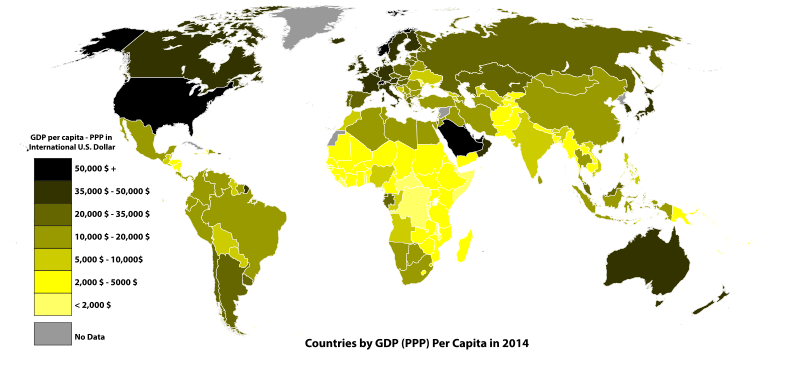
The map also shows the clear and rapid reversal of the patterns of wealth in the Americas that resulted from European colonisation. The Spanish crown were still powerful enough to keep their heads. Spain became a client state of France, but did not receive the revolutionary treatment that other parts of mainland Europe did and lost power over a lot of its American colonies. Despite being one of the wealthiest places in Europe for centuries, today Spain is less rich, less powerful, less liberal and more corrupt than their northern neighbours. This is the ultimate and far-reaching legacy of the influence of the American colonies it occupied.
The British kept their crown. The British monarchs were probably the weakest of the three identified earlier has having prototype citizens assemblies (Spain, France and Britain). They stayed in power and kept their heads by playing competing powers off against each other. In doing so, they inadvertently invented the ‘level playing field’ of economic inclusiveness, in addition to gradually yielding political power to the people. For example, being an island nation, they needed a Navy. They could not afford one. So they simply let people build their own ships and do (almost) anything they wanted. Thus was born the British Merchant Navy. Through a combination of good luck and good fortune, they defeated the nominally superior Spanish Navy, and set the British on a path to world domination, slightly ahead of their time.
The British started with the Americas. They got the dregs. When they tried to set up a slave-like social order it failed and a lot of people starved to death. Many wandered off and joined the natives. So they tried letting people sort themselves out. It worked. The conditions that kept the natives of North America backwards and slowed down European settlement were the same conditions that promoted personal freedom and eventually spawned the richest country on earth. The coldest, most backward of the European states from the original Roman footprint, with the weakest leaders, settled the cold dregs of the Americas the only way they were able to – as free men. Not long after, as free men, they took over the world.
What they took with them was a society in transition. Like the Romans, only a small social advantage was necessary to gain an edge over their competitors. Thus when we look at the detail of their expansion, we see the familiar contradictory achievements – in many cases ramping up the evil and injustice of the world they inherited by industrialising it, then transforming it into a society that can look back on its own very recent history with genuine disgust.
The rest, as they say, is history.
First published 30 April 2016
Last updated 20 May 2016

| 









